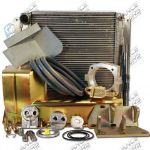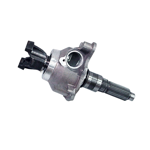How to Choose the Right Gear Ratio for Your 4x4: A Beginner's Guide
As much as people focus on engines, the gears are what let you use the power and torque they produce. Many have referred to gearing as “the great equalizer” when it comes to negotiating rough terrain or towing heavy loads.
Gearing is almost always talked about in terms of gear ratio. In this Gear Ratio 101 guide, our experts look at what these two words mean and how it affects off-road vehicles.
What is Gear Ratio?
Gear ratio is the relationship between the rates at which the driving gear and the driven gear rotate. The transmission gear ratio measures the ratio between the engine crankshaft and the driveshaft while the axle gear ratio compares the revolutions of the driveshaft and rear axle.
For example, say the transmission gear ratio is 3.5:1. This means that, for every one time the driveshaft turns, the engine turns 3.5 times. The lower the numerical value, the “taller” the gear ratio is and vice versa.
What Does the Gear Ratio Mean?
Higher gear ratios give a vehicle better acceleration and torque. Lower ratios are best for top speed and fuel efficiency. The higher the ratio, the faster the engine must run to reach a given speed.
Let’s look at the TREMEC TR4050 5-Speed Transmission. The ratios from first to fifth gear are 6.16, 3.11, 1.71, 1.00 and 0.76. The 6.16 ratio gives you acceleration for standing starts and torque for crawling or steep hills. The 0.76 ratio is ideal for highway cruising. To go 30 mph in first gear, your engine will have to turn 8.1 times as many RPMs as it would in fifth gear.
So What 4x4 Gears Should I Use?
For off-road 4x4s, you’ll want to look at the final drive ratio (FDR). To determine this, multiply the following numbers together:
- Transmission Gear Ratio
- Transfer Case Ratio
- Axle Gear Ratio (Differential Gear)
So assume you have the TR4050 transmission, an Atlas 2-Speed Transfer Case with a 3.8 low gear ratio and a 4.3 differential. Your maximum FDR will be 6.16 x 3.8 x 4.3 = 100.65.
Here are the final drive ratios that work best for different applications:
- Under 50 — Daily driving
- 50 to 79 — Backroads, light trails and towing
- 80 to 109 — Intermediate trails and heavy-duty towing
- 110 to 130 — Rock crawling
Anything over 130 has no real benefit on or off the road.
Tires & Gear Ratios
Note the calculation above assumes you’re using factory-size tires. Changing to a different tire size will proportionally alter the FDR. To see the effects, divide the diameter of the factory tires by that of the new tires and multiply by the FDR. This gives you the effective drive ratio (EFR). For example, switching from 28-inch to 30-inch tires would drop a 100.65 FDR to 93.94. Conversely, 26-inch tires would raise the ratio to 108.4. As such, swapping tires may require a new transmission, transfer case or differential to counter the gearing effects.
For help calculating your final gear ratio, please find our interactive tool below:























